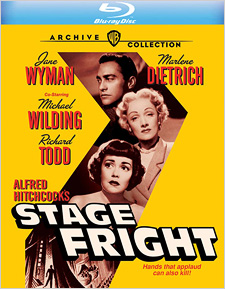Stage Fright (1950) (Blu-ray Review)

Director
Alfred HitchcockRelease Date(s)
1950 (January 25, 2022)Studio(s)
Transatlantic Pictures/Warner Bros. (Warner Archive Collection)- Film/Program Grade: B+
- Video Grade: A
- Audio Grade: B+
- Extras Grade: C-
Review
Stage Fright was the last film Alfred Hitchcock would make in the UK before returning one final time with Frenzy in 1972. Though it isn’t one of Hitchcock’s strongest pictures, Stage Fright does offer an intriguing plot, a sense of fun, and Marlene Dietrich.
Eve Gill (Jane Wyman), an aspiring actress, becomes involved in a murder mystery when she sets out to help boyfriend Jonathan Carter (Richard Todd) clear his name of a murder for which he was framed by his lover, stage star Charlotte Inward (Marlene Dietrich). In a lengthy flashback at the beginning of the film, Jonathan tells Eve the events that have caused him to be a fugitive from justice.
Eve figures the only way she can help Jonathan is by calling on her acting skills to conduct her own undercover investigation. She pretends to be a reporter to gather some preliminary information, a maid to gain access to Charlotte, and a flirt to get close to the lead detective (Michael Wilding) on the case. The theatricality of the story is emphasized by curtains, one opening on the credits and the other closing at the film’s end.
Hitchcock adds a light touch to the proceedings with the British supporting cast: Alastair Sim as Commodore Gill, Eve’s father; Sybil Thorndike as Mrs. Gill; Kay Walsh as the mysterious Nellie Goode; and rubber-faced Joyce Grenfell as the eccentric operator of a shooting gallery. Hitchcock’s daughter, Patricia, appears in a small role as a theater student.
Dietrich is the showpiece in Stage Fright. She performs a number that would become a signature song, The Laziest Gal in Town, especially written for her by Cole Porter. She also sings the Edith Piaf standard La Vie en Rose. Dressed in fabulous costumes by Christian Dior, she adds immense stature to the film and is its greatest asset. Her larger-than-life personality dominates every scene.
In Stage Fright, Hitchcock is telling us that everything we see or hear has multiple interpretations. There is no easily defined demarkation between artifice and reality. Several characters in the film fail or risk failure because of their inability to discern the truth and their willingness to be duped and exploited by others.
There’s controversy about that early flashback, which some regard as a major flaw and others consider a brilliant touch. It’s best not to provide details here, lest too much is revealed. Hitchcock himself felt that he had made a serious error but history has taken a kinder look. In the film’s context, the flashback works quite effectively and dramatically to supply insight into the mind of the narrator.
Stage Fright was shot by director of photography Wilkie Cooper with spherical lenses on black-and-white 35 mm film, finished photochemically, and presented in the aspect ratio of 1.37:1. This newly-restored release from Warner Archive, sourced from a recent 4K scan of the original nitrate camera negative, gives a nice sense of depth due to atmospheric shadows and astute back lighting. Clarity and texture are pleasing, and details such as the decor in Eve’s parents’ house, Charlotte’s home, and the costumes are nicely delineated. Marlene Dietrich is lovingly photographed, especially an extreme close-up of her face through a mist of cigarette smoke. In a tense climactic scene, actors’ eyes are illuminated while their faces remain in relative darkness. The Laziest Gal in Town number, with Dietrich in a white, flowing dress lounging on a white satin settee, is bathed in bright light, creating a mood of sheer elegance. Apart from this scene, the cinematography is fairly traditional and doesn’t have the visual pizzazz of later Hitchcock films.
The soundtrack is English 2.0 mono DTS-HD Master Audio. English SDH subtitles are an available option for the main feature but not for the featurette. Dialogue is clear and sharp throughout. Many of the actors are stage-trained, so their diction is impeccable. Dietrich’s voice is deep and seductive, and she elicits subtle laughs with her phrasing. Sound effects include the engine of a sports car as it races through town, a heavy metal curtain slamming down onto the stage, and gun shots during the amusing rifle range scene.
Bonus materials include the following:
- Hitchcock and Stage Fright (19:22)
- Theatrical Trailer (2:52)
In the making-of documentary Hitchcock and Stage Fright, several individuals weigh in on Stage Fright. Film historians Robert Osborne and Richard Schickel, filmmaker Peter Bogdanovich, director Richard Franklin (Psycho II), actresses Jane Wyman, and Patricia Hitchcock discuss the structure of the film and single out specific scenes. Wyman reminisces about Dietrich, who “mothered” her and advised that she “make them pay attention to you.” Richard Todd went on to play in thrillers on the English stage but never worked for Hitchcock again. Michael Wilding, an “agreeable actor,” was a star of British films. Patricia Hitchcock notes that she did the “danger driving” for Jane Wyman and was cast as a drama student because she was then a student at the Royal Academy of Dramatic Arts, the location of a key scene. Stage Fright is underrated these days for two main reasons: Hitchcock thought about it negatively in later years, and it pales in comparison to Strangers on a Train, made a year later. The film marks an end to one chapter in Hitchcock’s career and foreshadows more complexity in the director’s work.
What Stage Fright lacks in suspense and action it more than makes up for in comedy. A highlight is the rifle range sequence in which Alastair Sim tries desperately to get Joyce Grenfell to part with a toy doll. But there are spine-tingling moments, too, with dark foreshadowing of Hitchcock’s later film Psycho. The film’s quirkiness and sense of fun are what give it enduring appeal.
- Dennis Seuling

